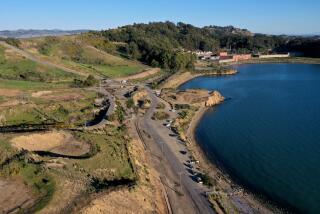Two $50,000 Donations : Gifts Bolster Push For 2nd Bay Entry
- Share via
The movement to promote the creation of a second entrance to San Diego Bay has been bolstered by two $50,000 donations in the last eight days. The money will be used to begin studying the massive effort needed to cut a new channel in the South Bay.
The Second Harbor Entrance Project Inc., a nonprofit organization dedicated to the idea of a South Bay channel, received a $50,000 research grant Tuesday from the San Diego Unified Port District and a like contribution from the San Diego City Council on Oct. 12.
“I’ve been talking to anyone who would listen for a couple of years and there really is a lot of support for the thing,” said Larry Peeples, a retired Rohr Industries spokesman who has led the effort since 1985 at the request of National City and Chula Vista leaders.
Answering Questions
“I think we have a really good opportunity to get it done,” Peeples said. “At this point, we’re not going to say that this is going to be built. At this point, we’re saying that we have to answer all the questions regarding environmental concerns, the sand deposition, the Tijuana sewage and the flushing action on the bay.”
The idea of cutting a second channel into the bay has been kicked around since 1935, when President Franklin D. Roosevelt proclaimed during a visit to San Diego that the city needed a backdoor to its bay for military purposes.
The most serious work on the mammoth project came during the 1960s, when the Army Corps of Engineers built a 2,500-square-foot model of the bay and determined that a second entrance would improve the bay’s tidal flushing action without eroding the deep-water channels used by commercial and military ships.
The Army Engineers ultimately concluded that there would be only 60 cents of economic benefit for each dollar spent on the project, a decision that spelled death for the effort. But before the decision, engineers identified two possible sites for a slice through the Silver Strand: near Crown Cove, just north of Coronado Cays, or at Emory Cove, just south of Coronado Cays.
Would Take Up to Eight Years
Though there are some who would like to see the project completed in time for the 1991 America’s Cup defense, engineers now studying the project for the nonprofit group estimate that it would take five to eight years, Peeples said. A 600-foot-wide, 48-foot-deep entrance would cost about $250 million, while a 400-foot-wide, 35-foot-deep channel would cost $180 million, he said.
With the two recent donations and $15,000 contributions from National City, Chula Vista and a developer, the organization is about half way toward its goal of collecting $300,000 in fiscal 1987-88. About $180,000 of the money would be spent on consultants, lobbyists and research, including one study now under way that will outline all the steps to be taken before construction can begin.
Included will be research into how the channel would affect nesting of the California least tern, marine life, eel grass, the Silver Strand and the flushing action of the bay, Peeples said. Several government agencies have expressed interest in funding some of the research, he said.
More to Read
Sign up for Essential California
The most important California stories and recommendations in your inbox every morning.
You may occasionally receive promotional content from the Los Angeles Times.













